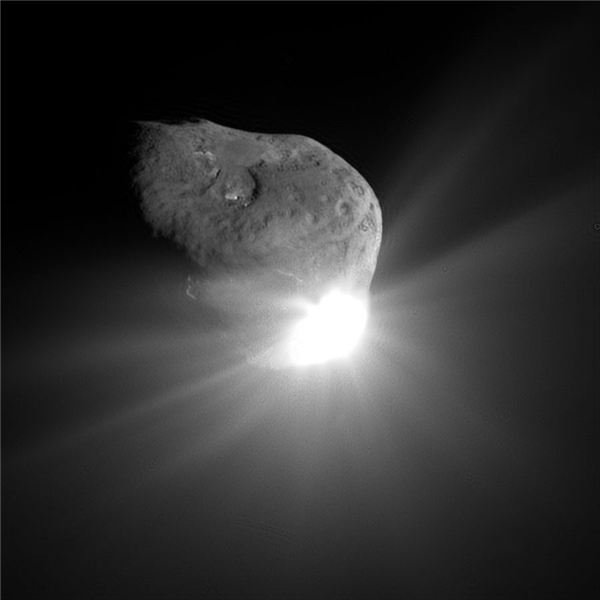NASA's Deep Impact Probe
What’s a Deep Impact?
The study of comets, for the longest time, has been nothing more than looking at them. From the human eye to telescopes to orbiting
satellites to probes, the only information we have been able to glean from comets has come from optical observation. In 2005 NASA launched its Deep Impact probe, which created an entirely new way for observing comets. The probe itself is made of two main parts: the flyby and the impactor. The flyby portion is the section that contained all the main telescopes and observation equipment. The impactor section is little more than a 370 kilogram (815 pound) hunk of copper with a camera on it, which was designed to slam into a comet to create an enormous crater and plume of debris. In the moments after the impact, the flyby section made observations that gave us new insight into the Tempel 1 comet.
Deep Impact Mission Highlights

The history of the Deep Impact Mission starts with Alan Delamere, a scientist at the National Optical Observatory in Tucson, Arizona. He first proposed the idea in 1996 to the NASA Discovery Program. The mission would not be accepted for two years, and the planning and design would start in November of 1999, lasting until May 2001. Construction of the Deep Impact probe would last 4 years, until it was finally launched at Cape Canaveral on a Delta II rocket in January 2005. The probe approached its target for 6 months until in July 2005 the impactor portion of the probe slammed into the surface of the comet Tempel 1. The flyby part of the probe then used its high and medium resolution imagers to observe the impact, as did many other telescopes in space and on the Earth.
With its primary mission completed, the flyby portion of the Deep Impact probe was still functional. At this

point, it was decided to extend the Deep Impact mission, renaming it EPOXI, which is short for Extrasolar Planet Observation and Deep Impact Extended Investigation. The probe’s new task was to observe planets outside of our Solar System and to gather data on the comet, Boethin. When it came time to make a course correction to find its new comet, astronomers were unable to find Boethin. There has been speculation that the comet did not survive its last orbit around the Sun, and was broken apart by tidal forces. Instead, the Deep Impact probe made a course correction on July 21, 2005 for the comet Hartley 2. The probe is expected to complete its journey to Hartley 2 on November 4, 2010. From there, Deep Impact will remain in space to hopefully discover extrasolar planets until it is no longer operational.
Sources
https://solarsystem.nasa.gov/deepimpact/mission/di-name.cfm
https://www.nasa.gov/mission_pages/deepimpact/mission/index.html
https://epoxi.umd.edu/1mission/status.shtml
Credits:
Alan Delamere: https://solarsystem.nasa.gov/deepimpact/images/Alan_Delamere.jpg
Tempel 1 Impact: https://epoxi.umd.edu/3gallery/newspics/Tempel_1_impact-lg.jpg
Deep Impact Probe: https://www.nasa.gov/images/content/90855main_dispcrft.jpg
